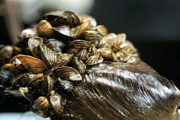Dangerous Dreissenid mussel is a concern to everyone
There’s a problem brewing in the lakes of B.C.
The Dreissenid mussel, which include Zebra and quagga mussels, is an invasive bivalve filter feeder that can cause extensive environmental and economic impacts in the ecosystems.
This has been a proven fact in in areas the Dreissenid mussel has become established.
“In an economic impact report prepared for Bonneville Power, a hydroelectric power generating company located in the US Columbia Basin, the onetime cost to install mussel treatment systems was estimated at more than $23 million dollars and the yearly costs were estimated at $1.5 million. ” said Sheila Street, Chair of the Central Kootenay Aquatic Invasive Species Working Group.
Dreissenid mussels can reach new water bodies through natural or human-aided transport. Natural dispersal occurs through drifting larvae (veligers), or by adults attached to floating objects.
Overland transportation by recreational boaters is the most likely pathway for the transportation of invasive aquatic species from established populations.
The Dreissenid mussel can attach in large masses to the hard substrates of pipes, dams, and diversion pathways restricting the flow of water through the system impacting equipment life, system performance, and maintenance activities.
Assessing the likelihood of a dreissenid mussel infestation in the Canadian Columbia Basin watershed is based on a number of factors including calcium levels, water temperature, flow rate and recreational usage. Calcium is physiologically important to dreissenid mussels, and they do not seem to establish in areas where the concentrations of dissolved calcium are below 12 mg/L.
Fortunately, the presence of dreissenid mussels has not been detected in the Columbia basin to date.
Prediction and early detection is fundamental to mitigation planning, which is why the Central Kootenay Aquatic Invasive Species Working Group has initiated the Kootenay, Columbia Sentinel Monitoring program.
Seven sites in the Kootenay, Slocan, Columbia and Pen d’Oreille watersheds were sampled twice each month during the summer and fall of 2012 to assess calcium levels and determine the presence or absences of dreissenid veligers.
The sites include boat launches and high use recreational areas where an infestation would be most likely to originate. These samples will be analysed under a microscope for the presence or absence of veligers.
“Ideally we would like to see regional support for a comprehensive socio- economic risk assessment of a dreissenid mussel infestation in the Canadian Columbia Basin, but this monitoring project will provide us with an excellent snapshot of where we are right now, ” said Crystal Klym, Executive Director for the Central Kootenay Invasive Plant Committee.
“With the recent finding of dead quagga mussels on a boat docked near Shuswap Lake, this project couldn’t be timelier.”
This project is being undertaken with the financial support of the Government of Canada through the Federal Department of Environment, as well as in-kind support from FortisBC, Ministry of Forests, Lands and Natural Resource Operations, Slocan Lake Stewardship Society and Central Kootenay Invasive Plant Committee.
The results of this study will be released in 2013.




















